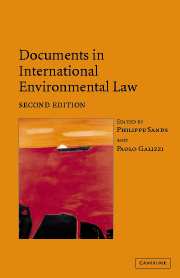Book contents
- Frontmatter
- Contents
- Preface
- PART I General instruments
- 1 Stockholm Declaration of the United Nations Conference on the Human Environment, 16 June 1972
- 2 UN General Assembly Resolution 37/7 on a World Charter for Nature, 28 October 1982
- 3 Rio Declaration on Environment and Development, 16 June 1992
- 4 Draft Articles on Prevention of Transboundary Harm from Hazardous Activities, 2001
- PART II Atmosphere
- PART III Oceans: global
- PART IIIB Oceans: regional
- PART IV Freshwater resources
- PART V Biodiversity
- PART VIA Hazardous substances and activities: nuclear
- PART VIB Hazardous substances and activities: pesticides
- PART VIC Hazardous substances and activities: waste
- PART VII Human rights and the environment
- PART VIII War and the environment
- PART IX Trade and the environment
- PART X Environmental impact assessment and access to information
- PART XI Liability for environmental damage and breaches of environmental obligations
- PART XII The Antarctic
3 - Rio Declaration on Environment and Development, 16 June 1992
Published online by Cambridge University Press: 05 June 2012
- Frontmatter
- Contents
- Preface
- PART I General instruments
- 1 Stockholm Declaration of the United Nations Conference on the Human Environment, 16 June 1972
- 2 UN General Assembly Resolution 37/7 on a World Charter for Nature, 28 October 1982
- 3 Rio Declaration on Environment and Development, 16 June 1992
- 4 Draft Articles on Prevention of Transboundary Harm from Hazardous Activities, 2001
- PART II Atmosphere
- PART III Oceans: global
- PART IIIB Oceans: regional
- PART IV Freshwater resources
- PART V Biodiversity
- PART VIA Hazardous substances and activities: nuclear
- PART VIB Hazardous substances and activities: pesticides
- PART VIC Hazardous substances and activities: waste
- PART VII Human rights and the environment
- PART VIII War and the environment
- PART IX Trade and the environment
- PART X Environmental impact assessment and access to information
- PART XI Liability for environmental damage and breaches of environmental obligations
- PART XII The Antarctic
Summary
Editorial note
The Rio Declaration on Environment and Development, adopted at the 1992 UN Conference on Environment and Development (UNCED), is intended to develop the principles adopted in the 1972 Stockholm Declaration.
The Rio Declaration comprises twenty-seven principles which set out the basis upon which states and people are to co-operate and further develop ‘international law in the field of sustainable development’ (Principle 27).
Although it is non-binding some provisions reflect rules of customary law, others reflect emerging rules, and yet others provide guidance as to future legal developments.
Principle 1 of the Rio Declaration reflects a shift towards an anthropocentric approach to environmental and developmental issues, declaring that human beings are ‘at the centre of concerns for sustainable development’, and that they are ‘entitled to a healthy and productive life in harmony with nature’; this falls short of recognising a right to a clean and healthy environment. The all-important Principle 21 of Stockholm has been transposed into Principle 2 of the Rio Declaration, the only change being the addition of the words ‘and developmental’ in relation to matters within national sovereignty. Also, Stockholm's Principle 22, which urged the formation of liability rules, has been repeated in slightly amended language in Principle 13 of the Rio Declaration.
The heart of the Rio Declaration is found in Principles 3 and 4, which should be read together to understand the political context in which they were negotiated and the trade-off they represent: a right to development (Principle 3) is tempered by the integration of environmental protection into the development process (Principle 4).
- Type
- Chapter
- Information
- Documents in International Environmental Law , pp. 17 - 23Publisher: Cambridge University PressPrint publication year: 2004
- 2
- Cited by



